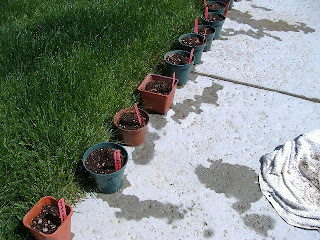If you're guessing that you "missed the boat" because you failed to start tomatoes and peppers from seed earlier this year, guess again!
If you've resigned yourself to visiting some nursery this weekend or next and be limited to what they have -- or don't have -- in stock -- don't give in!
You can still grow all the varieties of tomatoes -- cucumbers -- melons -- even pumpkins -- through an easy process called "Direct Seed."
"Direct Seed," you say? "What's that?"
Direct Seed is a fairly simple process where you place seeds directly into a planter cup filled with soil -- setting it in a sunny location that also offers some bottom warmth (this is critical) -- and letting it germinate on its own.
This is just one short project that Venus and I took part in last weekend while I was battling the dreaded Strep Throat. I didn't have much energy or desire to do anything to be completely honest, but direct seed is EASY. And, in no time at all, you can have the varieties of everything you want and more growing in your very own backyard.
That photo to your left? That's the result of a one-hour, direct seeding project. The wife and I found eight or nine old planter cups from past seasons (we tend to save them) -- filled them with planter mix purchased from a nearby nursery (you can also find acceptable planter mix at places like Longs or Rite Aide), drop in a few seeds, label and water.
That's it. Pretty simple stuff eh? Cup, soil, seed: that's all you need.
These starter cups filled with different varieties of watermelon, cantaloupe, cucumbers and pumpkins have already started to sprout. In another two to three weeks, they will be ready for a permanent home. This is the perfect time to plant cucumber or melon seeds because the weather is finally warm, and these are the types of plants that really need warm weather to thrive.
Of course, tomatoes started by the direct seed effort will be a bit behind than the starter plants that were nurtured by indoor growers during the winter months. That's to be expected. But eventually, with time , those direct seed plants will catch up to the early starts, and by the end of the growing season, you won't be able to tell one plant from another.
This is how Venus started varieties of Black Cherry and Kelloggs Breakfast tomatoes last year: Direct Seed. The harvest came a bit later -- but the harvest did eventually come - -and it was well worth the effort.
If you can find a sunny location in your yard -- preferably cement or brick -- you too can "Direct Seed" your garden. The brick or cement surface is crucial to direct seeding efforts. Seedlings LOVE heat and lots of it. When the afternoon sunshine starts to warm those surfaces, starter plants literally jump out of those cups. Plus, the reflecting heat can also aid plant growth once a seedling has broken to the surface.
I discovered this one year -- totally by accident -- when I started tomato plants from seed for the very first time. The starter cups that I had placed on a dirt surface weren't doing nearly as well as the nearby counterparts on a brick surface. I couldn't figure out the disparity until, one day, I was required to sit on the brick. Then it hit me: HEAT.
So -- remember -- cup, soil, seed -- that's all you need!
And Happy Gardening!



4 comments:
How about corn and beans? Does this method work for them also?
Keri, yes indeed. Direct Seed starts with just about anything.
I love direct seeding vegetables! Is there anything you wouldn't recommend for direct seeding?
Had bad luck with direct seeding corn. Cucumber and melon seed should be planting directly into the ground. But if you want to use a starter cup you can. Other than tomatoes, peppers, basil, eggplant and some flowers -- we direct seed everything into our raised beds.
Post a Comment